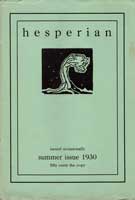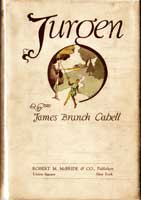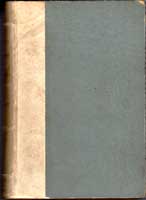james branch cabell
and arthur machen, certain
analogies between their early
works, by nathan van patten
Reprinted from The Hesperian, Summer Issue, 1930
 My first acquaintance with the work of James Branch Cabell dates from the purchase of a copy of the first edition of The Rivet in Grandfather's Neck shortly after its issue in 1915. I have since acquired his other books upon publication so that my library now contains a complete set of Cabell firsts (1915 to date) which have known no other owner.
My first acquaintance with the work of James Branch Cabell dates from the purchase of a copy of the first edition of The Rivet in Grandfather's Neck shortly after its issue in 1915. I have since acquired his other books upon publication so that my library now contains a complete set of Cabell firsts (1915 to date) which have known no other owner.
Ten years later, I came upon Arthur Machen's Three Impostors and was thereby induced to obtain first editions of his other books; my collection lacks only the unobtainable Eleusinia. These two writers have claimed much of my enthusiasm as a reader and attention as a collector.
It is generally accepted that in Jurgen1 Cabell brought forth a masterpiece and that Machen did likewise with his Chronicle of Clemendy.2 I have long fancied the existence of a spiritual kinship between Cabell and Machen but this was in no way the result of a studied comparison. Recently I re-read Cabell's Beyond Life 3 for the first time since my interest in Machen was established. It interested me greatly to find there several very pleasant references to Machen and his work. These I had not remembered from my previous reading of the book in question. This incident has induced me to begin a study of the work of the two men with the purpose of determining to what extent, if at all, Cabell may have been influenced by Machen.
Up to the present time, I have been able only to compare the two books mentioned at the beginning of the preceding paragraph. The following points seem to offer enough evidence to encourage further study of the works of these two men.
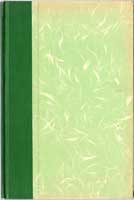 Both Cabell and Machen frequently quote non-existent authors and their works. In Jurgen we find references to Synopses of Aryan Mythology, by Angelo de Ruiz; Key to the Popular Tales of Poictesme, by John Frederick Lewistam; Origins of Fable, by Prote; Le Haulte Histoire de Jurgen, etc. The Chronicle of Clemendy offers The Red Book of Rabanus; The Joyous Inventions of the Monk Galliardus; Periphrasis, by Antonio de Calvados; Paictes et Gestes Joyeuses de la Cour Doree, and Le Roman de la Mouche, by Jehan Doucereutz. We are led to believe by both Cabell and Machen that these are books of very similar character.
Both Cabell and Machen frequently quote non-existent authors and their works. In Jurgen we find references to Synopses of Aryan Mythology, by Angelo de Ruiz; Key to the Popular Tales of Poictesme, by John Frederick Lewistam; Origins of Fable, by Prote; Le Haulte Histoire de Jurgen, etc. The Chronicle of Clemendy offers The Red Book of Rabanus; The Joyous Inventions of the Monk Galliardus; Periphrasis, by Antonio de Calvados; Paictes et Gestes Joyeuses de la Cour Doree, and Le Roman de la Mouche, by Jehan Doucereutz. We are led to believe by both Cabell and Machen that these are books of very similar character. - Both Cabell and Machen are exceptionally fertile in the adaptation and creation of names for persons and places to suit their own purposes. It would be difficult for anyone familiar with the work of Cabell and of Machen to separate into lists, as to source, a composite group of names including from Jurgen: Eglinton, Earl Roth, Bishop of Merion, Lisuarte, Camwy, Stevegonius, Penpington, Enisgarth, Morven, Evrawc, Caer Is, Gihon, Bembo, Holda, Gazden, Ziph, and North-galis, and from the Chronicle of Clemendy: Wentwood, Bishop of Llandaff, Humphrey, Loyse, Caldicot, St. Modoc, Penhow, Estrighoil, Eva, Caerwent, Skirrid, Blorenge, Honthy, Gavenny, Uske, and Netherwent. The frequency of names suggestive of Wales in both lists is notable,
- Frequently the same name occurs in both books. It is likely that this would be more striking if a complete list from all the works of both men were prepared for the purpose of comparison. A few names illustrative of this may be of interest. Cabell has Joyeuse Garde, Guenevere, Lancelot, Alianora, King Arthur, Caerleon, Merlin, Avalon, Dorothy, Theodoret, Evadne, while Machen presents Joyous Garde, Guinevere, Lancelot, Alianor, King Arthur, Caerleon, Merlin, Avilion, Dorothy, Theodota, Eva.
- Some of the episodes in Jurgen are reminiscent of others in the Chronicle of Clemendy. A striking example of this may be found by reading the account given by Cabell of the Library of Cocaign and that of Machen referring to the Library of Burgavenny. The occurrence of a Griffith the Delver in the Chronicle of Clemendy and of an Oriander the Swimmer in Jurgen is of equal interest.
- Both Cabell and Machen frequently introduce into their books bits of prose and poetry in French, Latin or Welsh purporting to be quotations. The originals are certainly obscure if indeed they exist at all.
- An extended comparison of the style of Cabell with that of Machen as displayed in Jurgen and the Chronicle of Clemendy would require space not at my disposal here. There exists an equal adeptness in the use of English suggestive of mediaevality. There is a quality in the writings of Cabell uncannily recalling that of Machen. Obviously each is deeply versed in the lore of Pan and the Silurists. Both have dreamed under the Golden Bough.
The following passages, taken the one from Jurgen, the other from the Chronicle of Clemendy, illustrate the resemblance which my fancy sees between the two:
". . . again they sit near the lake, under an apple tree older than Rome. The knotted branches of the tree are upraised as in benediction: and petals—petals fluttering, drifting, turning,—interminable white petals fall silently in the stillness. Neither speaks; for there is no need. Silently he brushes a petal from the blackness of her hair, and silently he kisses her. The lake is dusky and hard-seeming as jade. Two lonely stars hang low in the green sky ..."
"And on this day Sir Payne was lying according to his use by the Uske, keeping well in the hedge's shadow, and just above him with boughs falling to his hand was a great bush of pink roses, and here and there was a blossom almost as red as blood, but most were paler. But the odour came not to his nostrils since beside the rose bush grew an elder tree, the bloom of which is strongly fragrant, and it made the air heavy all around. And while he thus lay, pondering and dreaming and listening to the perpetual ripple of the river . . . the bell of the priory began to ring for Nonesong very sweetly, and looking up he noticed the roses, and a quaint thought came into his head . . ."
The interest of American collectors in the first editions of Arthur Machen seems to be waning. I cannot believe that this in any way presages that Machen is to be relegated to an obscure corner in the hall of fame. The author of The Hill of Dreams has earned the right to be numbered with the greatest masters of English prose.
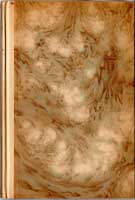 Cabell is likely to continue to be one of the outstanding Americans whose works are collected. His position in American letters seems equally well established. Already a number of books and articles have appeared which attempt to trace the sources both of his names for persons and places and the many obscure allusions appearing throughout his work. James P. Cover in his Notes on Jurgen quite frankly acknowledges his inability to trace many of these. Cover suggests that other Cabellians will desire to supplement his work on Jurgen and to attempt similar treatment for the other books. This may be the beginning of a voluminous Cabellian literature.
Cabell is likely to continue to be one of the outstanding Americans whose works are collected. His position in American letters seems equally well established. Already a number of books and articles have appeared which attempt to trace the sources both of his names for persons and places and the many obscure allusions appearing throughout his work. James P. Cover in his Notes on Jurgen quite frankly acknowledges his inability to trace many of these. Cover suggests that other Cabellians will desire to supplement his work on Jurgen and to attempt similar treatment for the other books. This may be the beginning of a voluminous Cabellian literature.
Nothing of this kind has been attempted for Arthur Machen although his books, in much the same way, offer inducement to a study of sources. Both Cabell and Machen have added illuminating introductions to certain of their books in the later editions.
In the introduction written by Machen for the Knopf edition of The Three Impostors he acknowledges his indebtedness to Stevenson, saying that it is "An imitation ... of Stevenson's Dynamiter and New Arabian Nights."
Certainly both of these men afford in their works an interesting field for speculation and inquiry. 'The comparison made between Jurgen and The Chronicle of Clemendy in this article is of necessity so limited in scope that there is no justification for the drawing of conclusions. If Cabell has patterned his magic weaving after the fabrics of Machen, it can be truly said that a great master of English prose has had a worthy disciple.
Notes:
1. First published in 1919.
2. First published in 1888.
3. First published in 1919.
